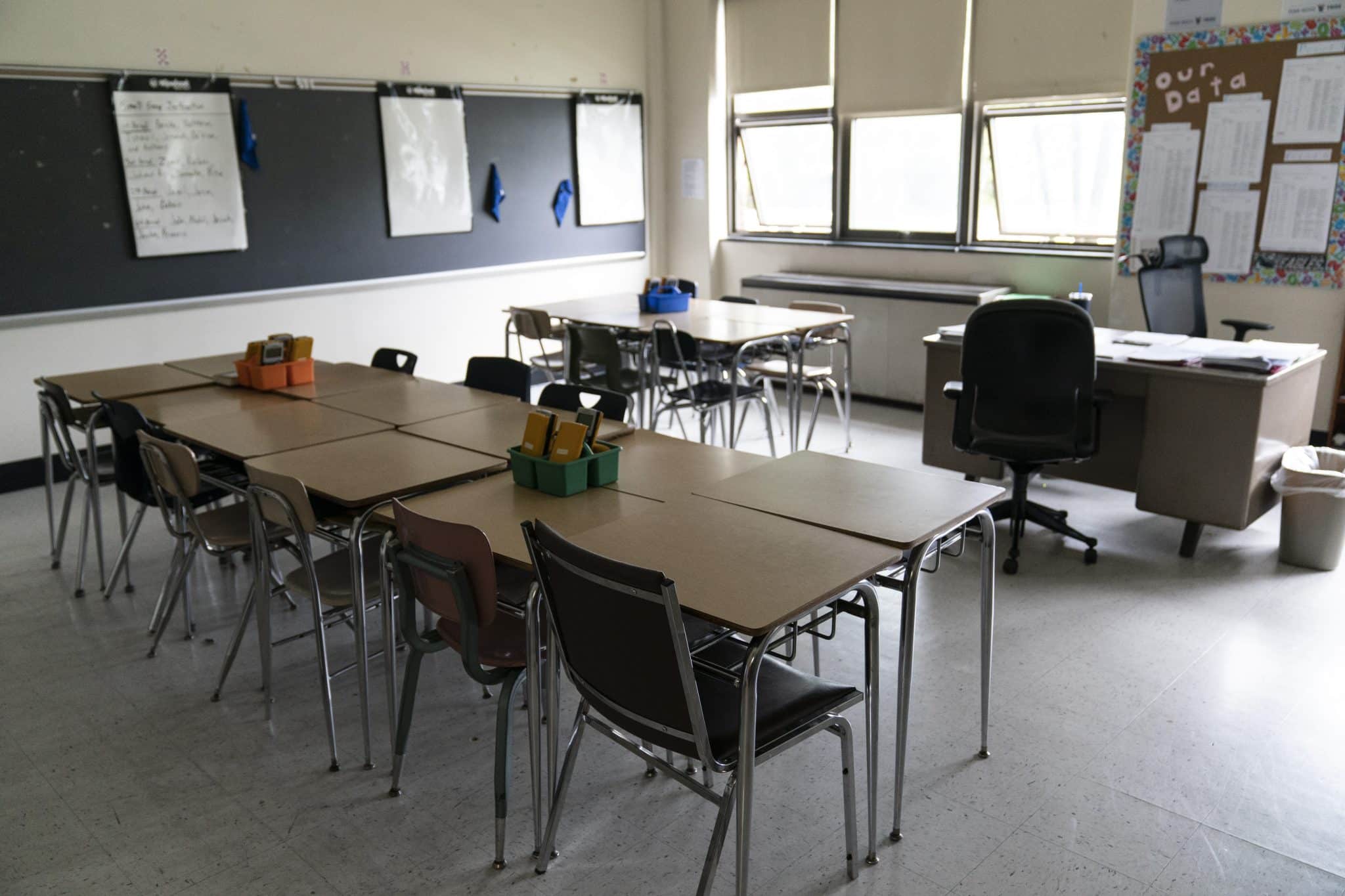At the school board meeting the evening before the first day of school, my local superintendent announced proudly, “We will be starting the year with every teaching position filled.”
In the United States in general, and Pennsylvania in particular, that’s no small achievement. In fact, difficulty filling teaching positions is now an international story. From Australia to Sweden, from England to America, leaders are trying to attract and keep people in the teaching profession.
Ed Fuller is a professor in the Education Policy Studies department of the College of Education at Penn State, and he says the Pennsylvania teacher pipeline has been in trouble for years. According to Fuller, the commonwealth has been trending downward since a teacher supply peak in 2012-2013, and while the decline seems to have stabilized in 2019, the teacher supply has remained stagnant and far below what Pennsylvania schools actually need.
At the beginning of the 2024-25 year, there were an estimated 49,000 vacant positions in U. S. public schools – somewhere between 2,100 and 2,500 of those vacancies were in Pennsylvania (depending on the accuracy of Philadelphia reporting). In fact, 38% of Pennsylvania’s 500 districts reported at least one vacant teacher position.
A report from Fuller and Emily Walsh at the Penn State Center for Evaluation and Education Policy Analysis breaks down the shortages into some important data points.
Where are the shortages worst?
When it comes to subject areas, no area is being hit harder than special education. For the last two years, at least a quarter of schools reported at least one unfilled position for special education. No other subject area comes close. Early childhood and elementary positions were unfilled in almost 10% of the entities still trying to fill positions at the beginning of the 2024-25 year.
If we look at vacancy rate (the percentage of positions that remain unfilled), special ed is still the leader, with a 3.2% vacancy rate in 2023-24. English Language Learner positions followed with a 2.4% rate, but it’s worth noting that there are far more special education teaching positions than ELL positions.
The difficulty filling special education positions is problematic because the students being served are among the most vulnerable in the school system; these are the students who most need well-qualified teaching specialists. But special ed positions come with extra challenges beyond what other teachers face in terms of hours of extra paperwork for developing and maintaining Individual Education Programs (IEP) as well as required meetings with parents.
READ: Pennsylvania’s Budget Impasse Causes Funding Headaches for Public School Administrators
There are problematic patterns in the larger picture of vacancies. Fuller and Walsh found a direct correlation between difficulty filling teaching positions and the percentage of students of color in the school. The more students of color, the more trouble filling teaching positions.
There is also a correlation between students living in poverty and unfilled teaching positions in both the 2023 and 2024 school years. The researchers divide the schools into five groups based on number of students living in poverty. For the top three quintiles of students living in poverty, there was little difference in unfilled positions, but the next-to-top and top quintiles showed considerably more trouble with unfilled positions.
When looking at how poverty connects to vacancy rates, the disparity is even more striking. The lowest three quintiles show a vacancy rate of around 0.5% for both years. The highest quintile shows a vacancy rate of well over 4%. The researchers ran these numbers both with and without Philadelphia schools and found little difference in the results.
So Pennsylvania is not just suffering from trouble filling teaching positions, but the fallout from that difficulty is landing disproportionately on students with special needs, students living in poverty, and students of color.
What is the source of this problem?
Pennsylvania appears to be suffering from simply a supply and demand problem. Teacher preparation programs are putting out fewer new teachers than schools need.
The issue is not new. In 2018, the Economic Policy Institute released a report citing research that showed a growing decline in teacher preparation program output:
The rate of Pennsylvania teacher certifications has declined by two-thirds between 2010 and 2015 (Benshoff 2016). College students are shunning education majors, with reports indicating that enrollment fell by 36 percent in traditional teacher education programs at the 14 Pennsylvania State System of Higher Education colleges (Palochko 2016). In 2013, 16,631 students graduated from teacher-training programs; by 2015, that number had dropped to 6,125, a 63 percent decline, according to data from the state’s Department of Education (PDE) reported on WHYY public radio in Philadelphia (Benshoff 2016).
College students may have shunned education in part because the state had started the teens by shedding jobs. In 2011-12, the state lost over 14,000 jobs; another 4,200 were lost the next year. High school students who came up in those days would have questioned whether a job would be waiting for them if they pursued a teaching degree.
READ: School Board Candidate Q&A: Carly Taylor – Pennridge School District
While the shortage in new teachers largely matches the openings discussed above, in some other cases the raw numbers are also striking. You may think that having a qualified computer science/tech ed teacher is critical in this day and age, but in 2024, a total of 12 new teaching certificates were issued for this subject. For world languages, only 55 new teachers were certified in 2024.
Fuller says that we need 8,000-10,000 newly certified teachers coming out of the pipeline every year, but for a decade we have seen, at best, a bit over 6,000.
It’s not just a matter of having enough teachers to fill every position. Even in districts that managed to fill their positions, those positions used to be filled by sorting carefully through a stack of applicants. Now the district may have to settle for whatever warm body applies for the job. Fewer new teachers in the job market means fewer chances for districts to pick the very best of the current crop.
Fuller says that the current rate of teacher attrition is “about as low as you can get.” His report from May 2023 shows that attrition rates are not the same for all teachers, with Black men showing the highest rate of departure. This is a long-standing issue; a federal Education Department study from 2015 that looked at teachers who entered the field in 2007-08 found similar results nationally, with men leaving at a higher rate than women and non-white teachers leaving at a higher rate than white teachers.
What are the solutions?
Some states have pursued recruitment from other parts of the world, with several states bringing teachers in from the Philippines. Many schools have been satisfied with that solution, particularly in very rural areas like Arizona, but now Filipino teachers are facing the possibility of being swept up in ICE raids.
Some states have reduced requirements for taking a teaching job. Florida passed a law saying any military veteran could be eligible for certification, even if they had not completed college. After 13 months, only 31 veterans had used the program. Several states have removed or weakened testing requirements for prospective teachers. In 2022, Arizona removed the requirement for a Bachelors Degree as long as the candidate was supervised by a fully certified teacher.
Like many states, Pennsylvania allows for emergency permission to teach in a classroom. The district must request an emergency permit for the individual to cover a class; the only requirement is a bachelor’s degree and clearances. In 2023-24, Pennsylvania issued 8,747 emergency permits.
That number underlines the state’s problem.
In 2021-22 for the first time, the number of emergency permits issued was greater than the number of new certificates issued to graduates, and that gap has only widened. As Fuller and Walsh point out:
Even if every newly certified teacher took a teaching position in Pennsylvania, they would still not replace every classroom led by a teacher on an emergency permit.
Laura Boyce, executive director of Teach Plus Pennsylvania, explained some of the drawbacks of emergency permits to Gannett’s Kai Lincke:
Research tells us that those teachers who are working on emergency permits, while many of them might be passionate and they could become great teachers with the proper training, on average, they are less effective (and) they are much more likely to not persist and to quit.
The best long term solution is to increase the number of students going into teaching, and this is the mystery that education leaders across the country are trying to crack. Some of the obstacles seem cultural and philosophical, as many in our country have moved from hailing teachers as heroes to loudly accusing them of being groomers and pornographers. Some of the obstacles are more practical; some districts have redefined the job as simply trying to prepare students to take the PSSA and Keystone exams. “I always dreamt of helping kids figure out what bubble to pick on a mediocre multiple choice test,” said no teacher ever.
In some parts of the state, demographics have kept pace with the staffing problem. Here in the rural northwest portion of the state, population drops have led to enrollment declines. When a teacher retires, their job may be easy to let go rather than taking the trouble to fill it, and financial pressures may make that choice attractive. In other words, if your school doesn’t have a staffing problem, chances are that it is dealing with a different set of problems.
How about Bucks County?
But in an area like Bucks County, where the population has grown every single year since the U.S. started counting, the challenge is tougher.
Bucks County does not face the most severe shortages in the state. Mapping loss of numbers of newly certified teachers between 2010-11 and 2023-24, Fuller and Walsh find several counties have lost huge numbers. Berks County has seen a decline of 375 fewer new teachers. Montgomery and Monroe counties have both seen a decline of well over 200 teachers. Bucks County has seen a decline of 47 new teachers.
In total, Fuller estimates that Bucks County needs an additional 190 qualified teachers, but only 35 teacher certificates were issued in the county in 2024. Meanwhile, 3% of Bucks County teachers are working with an emergency permit; 8% are teaching in classrooms “out-of-field.” Bucks County also has a large racial gap: 4% of the teachers in the county are persons of color, but 33% of the students are.
What can be done?
Fuller and Walsh offer several recommendations.
One is to reduce the cost of pursuing teacher certification. The state’s first steps in providing a stipend for student teaching is a step in that direction, but now that program has been launched in a sort of trial version, it’s time to fully fund it for all student teachers. The state could cover the costs of certification tests. The state could also provide scholarships and loan forgiveness programs to make pursuing teaching more affordable.
Fuller and Walsh also suggest a teacher preparation program quality review initiative. I agree — and I would further suggest that the programs be reviewed by actual classroom teachers. Nothing increases the likelihood of a teacher’s early departure from the profession than insufficient preparation for entering the classroom. Preparation and support increase the odds of early career success, which in turn increases the odds of a desire to stay and teach.
READ: Trump’s Agenda 47, Like Project 2025, Wants to Dismantle Public Education
Several Bucks County districts are creating Grow Your Own programs. These sorts of programs have been used successfully in many regions. They come in two types. One is aimed at getting high school students interested and started on the teaching career path. The other works with adults already working in schools in non-teaching roles to get additional education and teaching certification. This works well because they already have a realistic sense of what working with students is like. Both versions of GYO programs benefit the district by providing a supply of teachers who understand the community because they already have roots there.
There are other things that would help, like shifting the culture back toward support and respect for teachers, or getting Harrisburg to follow the court directive to fix school funding in Pennsylvania. But those are perhaps more difficult solutions that local districts cannot influence.
None of the possible solutions will bear fruit immediately, but another decade of an undersupply of teachers will certainly not help the state thrive or compete.







